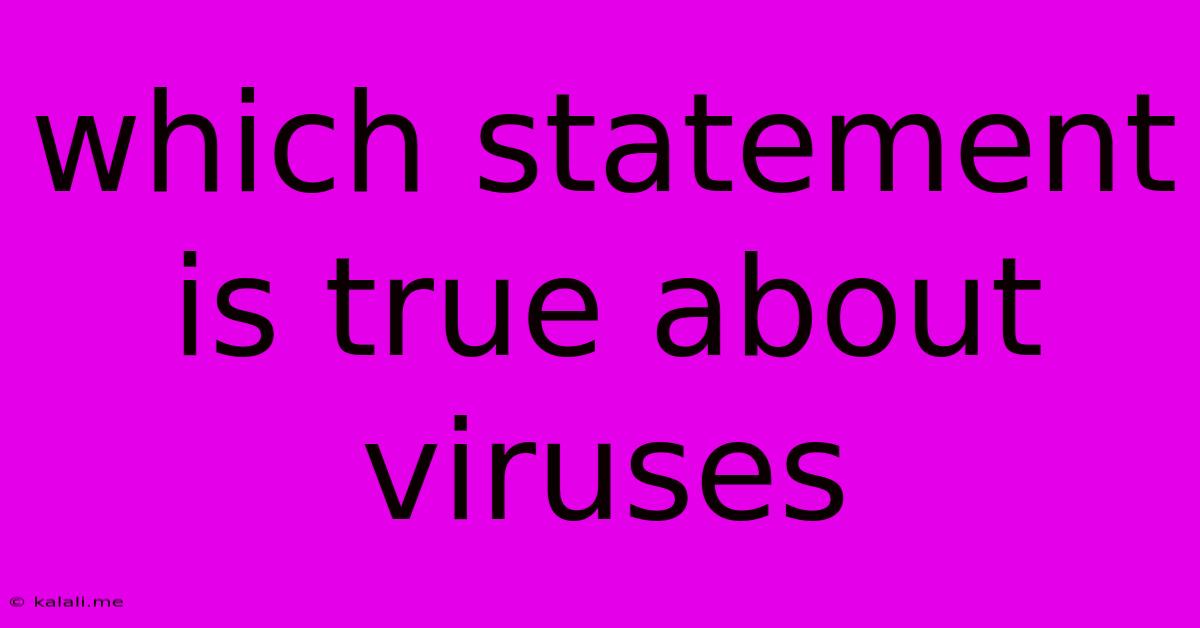Which Statement Is True About Viruses
Kalali
Jun 15, 2025 · 3 min read

Table of Contents
Which Statement is True About Viruses? Deconstructing the Nature of Viruses
Viruses are fascinating and often misunderstood entities. They blur the line between living and non-living things, leading to much debate and confusion about their fundamental nature. This article will explore several common statements about viruses and determine which accurately reflect their characteristics. Understanding viruses is crucial, not only for appreciating their biological intricacies but also for combating the diseases they cause.
What are Viruses? A Quick Overview
Before diving into the true and false statements, let's briefly define what viruses are. Viruses are submicroscopic infectious agents that replicate only inside the living cells of other organisms. They are essentially genetic material (DNA or RNA) enclosed in a protein coat. Unlike bacteria, which are self-sufficient, viruses are obligate intracellular parasites, meaning they require a host cell to survive and reproduce. This parasitic nature is central to understanding their behavior and impact on living organisms.
Statement Analysis: Sorting Fact from Fiction
Let's analyze some common statements about viruses to determine their accuracy:
Statement 1: Viruses are living organisms.
FALSE. While viruses exhibit some characteristics of living organisms, such as the ability to replicate and evolve, they lack many others. Crucially, they cannot metabolize independently and require a host cell's machinery to reproduce. Their inability to function outside of a host cell is a key reason why they are generally considered non-living entities.
Statement 2: Viruses can be killed by antibiotics.
FALSE. Antibiotics target the cellular processes of bacteria, but viruses lack the cellular structures that antibiotics affect. Antiviral medications, on the other hand, work by targeting specific viral processes or inhibiting viral replication within host cells. This highlights the fundamental difference between bacterial and viral infections and the need for different treatment strategies.
Statement 3: Viruses are responsible for many infectious diseases.
TRUE. Viruses are the causative agents of a vast array of diseases, ranging from the common cold and influenza to more severe illnesses like HIV/AIDS, Ebola, and COVID-19. Their ability to infect and replicate within host cells leads to a wide range of symptoms and pathologies. Understanding the specific mechanisms by which viruses cause disease is vital for developing effective treatments and prevention strategies.
Statement 4: Viruses can infect only animals.
FALSE. Viruses are highly diverse and infect a broad range of organisms, including animals, plants, bacteria (bacteriophages), and even archaea. The specific types of cells a virus can infect depend on its host range, which is determined by the interactions between viral surface proteins and host cell receptors. This broad host range underscores the pervasive impact viruses have across the biological world.
Statement 5: Viruses evolve rapidly.
TRUE. Due to their high mutation rates and rapid replication cycles, viruses can evolve rapidly, adapting to changes in their host environments. This ability to adapt is a significant challenge in developing long-lasting vaccines and antiviral therapies. The emergence of new viral strains and the evolution of drug resistance are prime examples of this rapid evolutionary capacity.
Conclusion:
Understanding the true nature of viruses is crucial for developing effective disease prevention and treatment strategies. While they are not considered living organisms in the traditional sense, their impact on living organisms is profound and far-reaching. Their ability to evolve rapidly and infect diverse hosts necessitates continued research and development to combat the challenges they pose to human health and global well-being.
Latest Posts
Latest Posts
-
Distinguish Between A Neuron And A Neuroglial Cell
Jun 16, 2025
-
Which Of The Following Is True About Compounds
Jun 16, 2025
-
45 Is What Percent Of 225
Jun 16, 2025
-
Give A Suitable Title To The Above Passage
Jun 16, 2025
-
Which Of The Following Is Not A Problem Solving Strategy
Jun 16, 2025
Related Post
Thank you for visiting our website which covers about Which Statement Is True About Viruses . We hope the information provided has been useful to you. Feel free to contact us if you have any questions or need further assistance. See you next time and don't miss to bookmark.